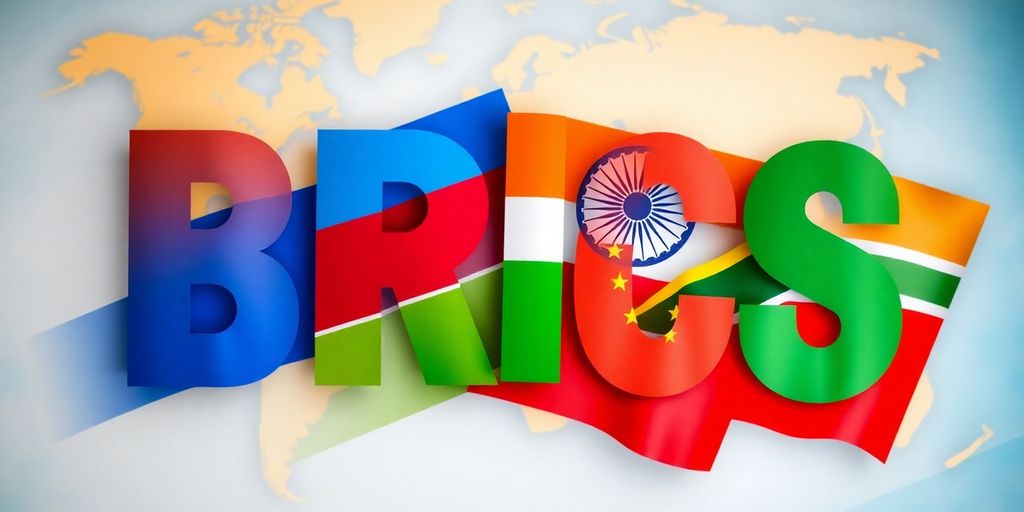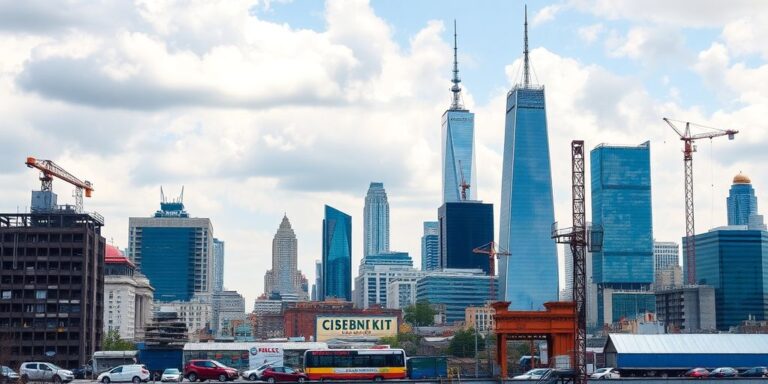The emergence of the BRICS represents a major turning point in the global economy. Composed of fast-growing countries like Brazil, Russia, India, China, and South Africa, this group has recently expanded to include other nations. Together, these countries seek to strengthen their influence on the international stage and redefine global economic dynamics. This article explores the origins, evolution, economic influence, and challenges faced by the BRICS, while questioning whether they can truly become the new leaders of the global economy.
Key Points
- The BRICS represent nearly 50% of the world’s population and 26% of global GDP in 2024.
- The group was founded in 2009, with four countries, and was expanded in 2011 with South Africa.
- The BRICS seek to reform international institutions to better reflect their economic weight.
- China plays a central role in the growth and influence of the BRICS on a global scale.
- Challenges include social and economic inequalities, as well as criticisms of their economic model.
Origins and Evolution of the BRICS
Birth of the BRIC Concept
The acronym BRIC was created in 2001 by economist Jim O’Neill. It refers to four countries: Brazil, Russia, India, and China. These countries were identified as having significant economic growth potential. Indeed, between 2000 and 2008, the growth of the BRICS was significantly higher than that of developed countries. This group was formed to showcase the growing importance of these economies on the global stage.
South Africa’s Membership
In 2011, South Africa joined the group, transforming BRIC into BRICS. This marked an important milestone in the evolution of this group, which began to meet annually to discuss economic and political issues. These summits have strengthened cooperation among members and asserted their influence on the international stage.
Expansion to BRICS+
In 2024, the group expanded to include five new members, thus becoming BRICS+. These new members are Saudi Arabia, Egypt, United Arab Emirates, Ethiopia, and Iran. This expansion represents a major turning point, as it reflects the growing importance of emerging countries in the global economy.
| Year | Key Event | Details |
|---|---|---|
| 2001 | Creation of the term BRIC | Jim O’Neill, Goldman Sachs |
| 2011 | South Africa’s Membership | Transformation into BRICS |
| 2024 | Expansion to BRICS+ | Addition of 5 new members |
The BRICS represent a significant share of the world’s population and global economy, making them an essential player in international discussions.
Economic Influence of the BRICS

Global Economic Weight
The BRICS, which include countries like Brazil, Russia, India, China, and South Africa, represent more than a quarter of the global economy. In 2024, these countries are expected to continue growing, thereby influencing the global economy. Here are some key points:
- 22% of global growth will come from China.
- 15% of growth will be generated by India.
- Together, the BRICS represent nearly 50% of the world’s population.
Growth and Challenges
The growth of the BRICS is impressive, but it is not without challenges. The countries must face increasing social and economic inequalities. Here are some major challenges:
- Inequalities within member countries.
- Environmental issues related to rapid growth.
- Political instability in some countries.
China’s Role
China is often seen as the engine of BRICS growth. Its contribution to the global economy is significant, surpassing that of all G7 countries combined. Indeed, China plays a crucial role in the economic development of other BRICS countries, particularly through investments and trade partnerships.
In summary, the BRICS are becoming key players in the global economy, but they must overcome internal challenges to realize their full potential.
| Country | Contribution to Growth (%) |
|---|---|
| China | 22 |
| India | 15 |
| Other BRICS | 10 |
The BRICS Summits

Institutionalization of the Summits
The BRICS summits began in 2009 with the meeting of the four founding countries: Brazil, Russia, India, and China. The first summit took place in Yekaterinburg, Russia. These meetings have created a new geopolitical dynamic. Over the years, South Africa joined the group, transforming BRIC into BRICS.
Major Historical Summits
Here is an overview of the most significant summits:
| Year | Location | Key Event |
|---|---|---|
| 2009 | Yekaterinburg | First BRIC summit |
| 2011 | Sanya | South Africa’s Membership |
| 2015 | Ufa | Inauguration of the New Development Bank (NDB) |
| 2021 | Video Conference | Declaration on unequal access to vaccines |
| 2023 | Kazan | Expansion to BRICS+ |
Impact of Decisions
The decisions made during the summits have a significant impact on economic and political cooperation among member countries. Notable outcomes include:
- The creation of the NDB to finance development projects.
- The commitment to promote enhanced multilateralism.
- The establishment of common strategies to address global challenges.
The BRICS summits represent an essential platform for discussing the concerns of developing countries and for strengthening their voice on the global stage.
Political Positioning of the BRICS

Reform of International Institutions
The BRICS are calling for a reform of international institutions to better represent the new global powers. Currently, these countries hold only 15% of the voting rights at the World Bank and 10% at the IMF, despite representing 42% of the world’s population. This shows an imbalance in the representation of emerging countries.
Unified Voice on the Global Stage
BRICS members seek to speak with one voice on important issues. They want to strengthen their influence in forums like the G20 and the WTO. For example, during their summit in 2011, they emphasized the need to reform the international monetary system. This shows their willingness to move away from dependence on the US dollar.
Internal Divergences
Despite their cooperation, the BRICS face internal divergences. Each country has its own interests and priorities. For example, China and India have historical tensions, while Russia uses the BRICS to counter the West. These differences can sometimes complicate their common position on the international stage.
The BRICS represent a new dynamic in international relations, but their internal divergences can hinder their effectiveness.
In summary, the BRICS seek to reform international institutions, to express themselves with one voice, but must navigate through sometimes divergent interests.
Challenges and Criticisms of the BRICS
Social and Economic Inequalities
Member countries of the BRICS face significant social inequalities. Despite their economic growth, a significant portion of the population lives below the poverty line. Here are some key points:
- Income inequalities are pronounced, especially in India and Brazil.
- Poverty remains a major issue, affecting millions of people.
- Governments must find solutions to improve the situation of the most disadvantaged.
Criticisms of the Economic Model
The BRICS economic model is often criticized for its lack of sustainability. Experts point out several issues:
- Excessive dependence on exports, particularly for China.
- Low transparency in economic practices, especially in Russia.
- Stagnation of productivity in some countries, such as Brazil and Russia.
Environmental Issues
The BRICS also face significant environmental challenges. Countries must balance economic growth and environmental protection. Here are some issues:
- Increasing pollution in major cities.
- Management of natural resources, particularly water and energy.
- Insufficient commitments to international climate agreements.
The BRICS must navigate between economic growth and social responsibility to ensure a sustainable future.
In summary, although the BRICS represent a growing economic force, they must overcome major challenges to realize their potential on the global stage.
The Future of the BRICS in the Global Economy

Growth Forecasts
The BRICS are well-positioned to become economic leaders in the coming years. According to forecasts, their growth could represent a significant share of the global economy. Here are some key points:
- The BRICS are expected to contribute to more than 25% of global growth by 2029.
- China, in particular, could account for 22% of this growth, surpassing G7 countries.
- India is also expected to be a growth driver, with a contribution estimated at nearly 15%.
New Members and Influence
The expansion of the BRICS with the addition of new members could strengthen their influence. Countries joining the group will bring:
- Greater economic diversity.
- Increased demographic weight, representing almost half of the world’s population.
- A stronger voice in international discussions.
Toward a Multipolar World
The BRICS aspire to a multipolar world, where multiple powers coexist. This could translate into:
- A reform of international institutions to better reflect new economic realities.
- Increased cooperation among member countries to counter Western influence.
- Development of new economic and political alliances.
In summary, the future of the BRICS looks promising, but it is crucial that they overcome their internal challenges to realize their potential on the global stage.
The BRICS, a group of growing countries, play an increasingly important role in the global economy. Their future looks promising as they seek to strengthen their influence and collaborate more. To learn more about the opportunities this may offer, visit our website and discover how you can benefit!
Conclusion
In summary, the BRICS, which include countries like Brazil, Russia, India, China, and South Africa, as well as new members, play an increasingly important role in the global economy. In 2024, these nations represent almost half of the world’s population and a significant share of global gross domestic product. Their goal is to strengthen their influence against traditional powers like the G7. However, despite their potential, challenges remain, including economic and political differences among members. The BRICS seek to promote a more balanced world, but their success will depend on their ability to overcome these obstacles and work together for a common future.
Frequently Asked Questions
What are the BRICS?
The BRICS group includes five countries: Brazil, Russia, India, China, and South Africa. They meet to discuss economic and political issues.
Why did South Africa join the BRICS?
South Africa joined the BRICS in 2011 to represent the African continent and strengthen the voice of emerging countries.
What is the economic impact of the BRICS?
The BRICS represent a significant share of the global economy, with nearly 26% of global gross domestic product in 2024.
What are the main criticisms of the BRICS?
Criticisms focus on economic and social inequalities within member countries, as well as their different political systems.
How do the BRICS influence global politics?
The BRICS seek to reform international institutions to better represent emerging countries and promote a multipolar world.
What is the future of the BRICS?
The future of the BRICS looks promising with the addition of new members and continued economic growth, but challenges remain.





